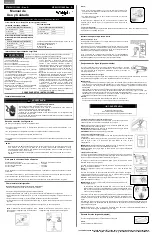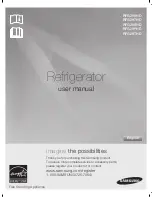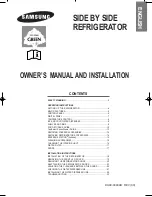
Cooler dimensions required for its use.
Anti-Bacterial
®
Air Filter (some models)
Your refrigerator has an Anti-Bacterial
®
air filter that helps maintaining a cleaner environment inside
the refrigerator, slowing the growth of bacteria present in meat and vegetables.
The Anti-Bacterial
®
filter should be changed every 6 months, because after this period of use, it
loses its anti-microbial properties. It is recommended to contact the authorized Service for
guidance on replacement of the filter and its installation.
To put back the Anti-Bacterial
®
fi lter:
1.
Locate the Anti-Bacterial
®
filter inside your refrigerator next to the
ventilation grille on the inside wall, just above the vegetable drawer
cover.
2.
Press with your index finger and gently pull the top flap of the filter
cartridge to remove it (see illustration).
3.
Insert the new filter in the same place, making sure that it is correctly positioned in the cavity.
Push it gently until it clicks into place.
To replace the refrigerator / freezer lamp
1.
Disconnect the power plug.
2.
Remove the top grid.
3.
Remove the plastic cover (snap in).
4.
Remove the bulb which is behind the panel.
5.
Replace it with a LED lamp W10574850 number (3.6 W) or a 25 W lamp for home appliances.
Ask it in our service centers or to the closest household appliances parts supplier.
NOTE:
Some LED lamps are not recommended for wet environments, such as refrigerator and
freezer compartments. If you use a LED lamp brand different from the one recommended by
Whirlpool, read and follow the package directions before using it.
6.
Replace the plastic protection.
7.
Connect the power plug.
NOTE:
Not all lamps are suitable. Be sure to replace with a new one with the same electrical
characteristics, shape and size.
A
B
C
D
A
B
C
D
1737
716
808
1446
1691
716
808
1446
Dimensions
Dimensions
mm
mm
Refrigerator 18 cuft
Refrigerator 16 cuft
Noises considered normal
Your new refrigerator may make noises, most of these noises are normal, however, hard surfaces
such as floors, kitchen walls and the refrigerator may make them more audible.
Low-level noise, low whistle
Characteristic noise ventilation and moving air.
Noise blows or crackles
Characteristic noise of the thermostat when the operation of the refrigerator stops or starts.
It also occurs when the refrigerator is making defrosting.
Water Noise
After the compressor stop it can be heard a characteristic sound of trickling water. It means that
the water is dripping into the drip tray. Characteristic noise of falling water on a hot surface during
the defrost cycles.
Compressor Noise
During the compressor operation that circulates the refrigerant gas, a weak intermittent noise is
emitted which may be garbled or slightly more intense, depending on the product location.
Engine characteristic noise. It means that the compressor is operating.
Ventilation Noise
The internal fan system is in charge of distributing the air inside the unit and may emit a low-level
noise during this operation, particularly when the freezer door is open.
Cleaning the exterior
See the information on the exterior cleaning specific for your model.
Style - Smooth painted door or Stainless Steel
IMPORTANT:
The warranty does not cover damage caused to the smooth finish due to improper
use of cleaning products or use of non-recommended cleaning products. The use of sharp and
pointed objects can damage the finish of your refrigerator.
USE
✔
Soft, clean cloth
DON’T USE
X
Coarse cloth
X
Paper towel or newspaper
X
Steel mops and sponges
USE
✔
Warm water and soap / neutral detergent
DON’T USE
X
Liquid abrasive cleaner
X
Glass cleaner
X
Chlorine
X
Ammonia
X
Acids (citrus) or vinegar based cleaners
X
Oven Cleaners
X
Flammable liquids
NOTE:
Paper towels can make opaque the transparent finish of the painted door. To avoid possible
damage, use only soft and clean cloth to polish and clean the door.
Avoid the contact of abrasive and corrosive materials with the stainless steel parts, such as high salt
concentrations and moisture or humid environments. Use only cleaners and cloths recommended
for stainless steel.
NOTES:
•
If contact occurs, unintended, with these materials, clean the plastic part with a sponge dipped
in warm soapy water / neutral soap. Dry thoroughly with a soft, dry cloth.
•
Liquid cleaners can be abrasive. When in contact with smooth surfaces they can damage the
stainless steel.
•
Citric acid can discolor forever the stainless steel. To avoid damage to the finish of your
refrigerator avoid contact of that material with your product.
Do not allow these substances to remain on the surface of your product:
X
Mustard
X
Tomato juice
X
Citric dressings
X
Products based on citrus sauces to marinate
IMPORTANT:
The door of your refrigerator is not reversible,
so the aperturewill always be toward the same side.
Before discard your old refrigerator
Remove the doors.
Leave the shelves in place so that children can not enter.
How to use the refrigerator with a mechanical control (some models)
Set the temperature control
Temperature control is in the refrigerator compartment.
When connecting for the first time:
•
Set the temperature control to position 3 (normal).
The control goes from 1 “Min” (less cold) to 5 “Max”
(colder).
•
By moving the temperature control to “Off”, both the refrigerator compartment and the freezer
will no longer cool, but the power will not turn off.
•
Before placing food in the refrigerator, let it run for a few hours, until it is completely cool. Set the
temperature control as needed. The previously suggested instructions are indicated for normal
household use.
Explosion Risk
Use cleaning materials that are not fl ammable.
Failure to follow these instructions may bring risk of death, explosion or fi re.
Defrosting takes place automatically. However, make a clean sweep in the refrigerator and freezer
compartments at least once a month, to prevent the accumulation of odors. Clean up spills
immediately.
To clean your refrigerator:
1.
Unplug the refrigerator and disconnect the power plug.
2.
Clean the inside of your product using a sponge and a cloth dipped in warm soapy water or mild
soap. Rinse well and dry with a clean, dry cloth.
3.
To clean the metal exterior surfaces painted and stainless steel (some models) use a sponge or
a cloth soaked in warm soapy water or mild soap.
NOTE:
Do not use abrasive and harsh cleaners such as glass cleaner, cleaning polishes, flammable
liquids, cleaning waxes, concentrated detergents, bleaches or cleaning oil products on plastic parts,
interior trim and door or gaskets. Do not use paper towels, mops and other harsh cleaning tools.
REFRIGERATOR CARE
Cleaning
How to use the refrigerator with electronic control (some models)
Your refrigerator has an electronic control of high technology that is located in the internal compartment of the
refrigerator, and can be easily used.
When connecting for the first time
:
When you connect the refrigerator for the first time to the electrical supply, the control will show all the
indicators blinking at the same time.
Temperature control
The temperature control of your refrigerator is smart. You can adjust the temperature of the product
compartment with it according to your needs.
To adjust the temperature of the compartment of the refrigerator:
The product has a factory recommended temperature, to adjust this temperature you only have to push the
“Setting” button. This change decreases the product temperature, the change is unidirectional from “Cold” to
“Coldest” (Left to Right). Once the control is set in “Coldest,” when you push the button again, it will go to a
less colder temperature (Cold).
This is the coldest temperature (Coldest) in the
product. All the indicators will be lighted.
The lowest temperature setting will be shown with the
first indicator (Left to Right).
The minimum average temperature will be shown once
the “Setting” button is pushed from the less colder
temperature. The second indicator will be lighted.
The “recommended” temperature will be shown when
the third indicator is lighted.
The fourth indicator will be lighted when the “Setting”
button is pushed from the “recommended” temperature.
NOTE:
To turn off the refrigeration system, you must hold the “Setting” button down for 4 seconds and release.
No indicator will remain lighted. Therefore, the refrigerator and the freezer will stop cooling, but it is not
disconnected from the power supply. To turn on again the refrigeration system, hold the “Setting” button down
for 4 seconds and release.
Summary of Contents for WT1715Q
Page 5: ... ...


























